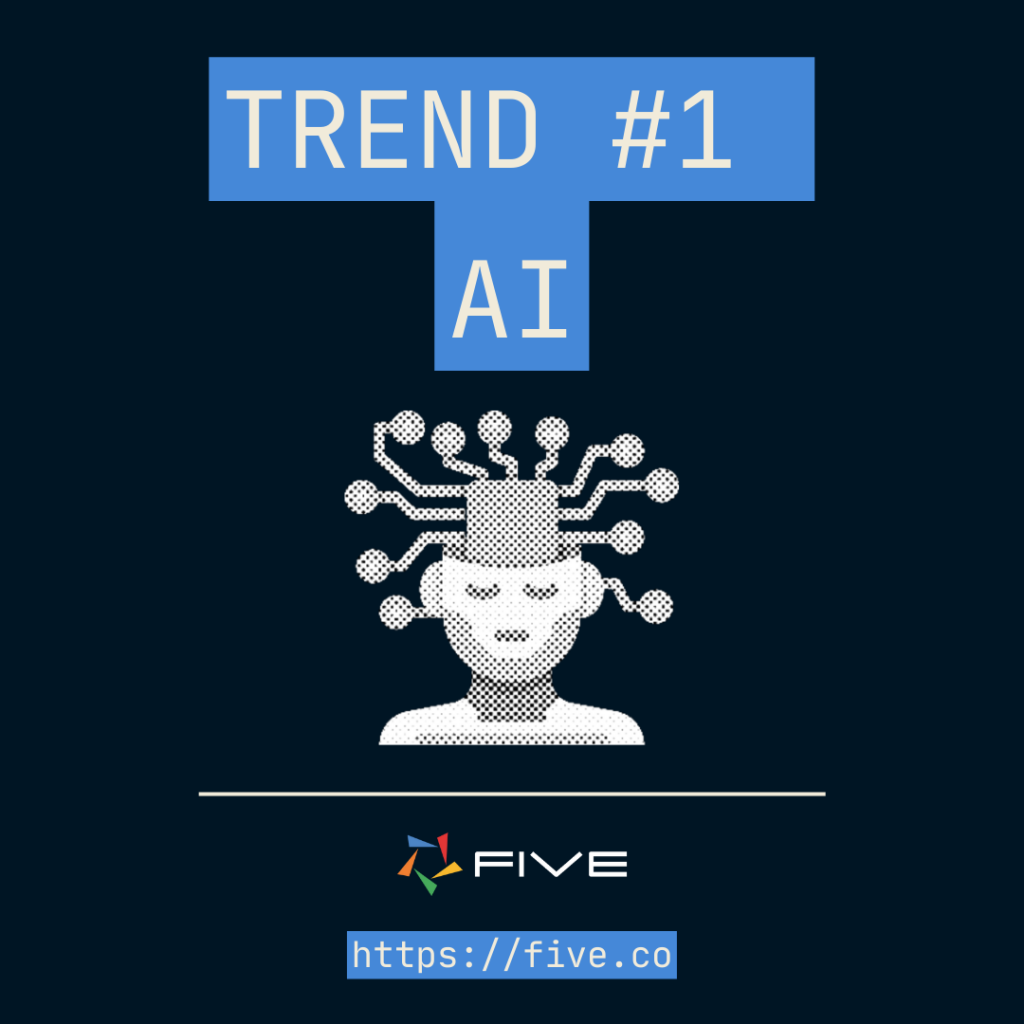Most Important Application Development Trends: AI, Cloud, and Low-Code

Unpack the impact of Artificial Intelligence (AI), the Cloud, and innovative Low-Code platforms.
Application development is leading the charge in transforming how businesses operate, communicate, and deliver value to their customers. At the forefront of this transformation in 2023, three pivotal application development trends stand out, signaling both the direction we’re headed in and the tools we’ll use to get there. Dive in as we unpack the impact of Artificial Intelligence (AI), the omnipresent Cloud, and innovative low-code platforms.
Table of Contents
The Growing Role of AI

This year’s Stack Overflow developer survey unveiled some fascinating insights into application development trends and the world of AI in app development. Here are the main takeaways:
Developer Sentiments on AI: A Deep Dive
- Are Developers Using AI? Yes, they are. 44% are currently integrating AI tools into their workflow, and an additional 26% plan to do so soon. Notably, a whopping 55% of those still learning to code use AI tools, forecasting a potential surge of AI tool usage as these novices become professionals.
- Which AI Tools Dominate? Despite having 21 AI tools listed in the survey, most developers rely heavily on just two: ChatGPT (83%) and GitHub Copilot (56%).
- Trust Issues: Trust is still a significant concern. A mere 3% of developers fully trust the accuracy of AI tools. In contrast, 6% don’t trust them at all, while 39% are on the fence, indicating AI tools still have some proving to do.
Geographic AI Adoption Trends
- High Adoption Rates: Developers in India, Brazil, and Poland lead the charge, with 70% or more either using or planning to incorporate AI tools into their workflows.
- Resistance in the West: Developers in the UK, France, US, and Germany are more hesitant about adopting AI tools. Potential factors include looming EU regulations, concerns regarding AI tool accuracy, and company policies against specific AI tools, such as ChatGPT.
AI Tools: The Road Ahead
- Why Use AI Tools? Developers are generally optimistic about AI’s potential, with 77% expressing a positive outlook. Specific sectors, like blockchain, data science, and front-end/fullstack development, show a higher inclination to use these tools.
- AI’s Limitations: AI’s code generation capabilities are impressive, but its capability to tackle intricate solutions diminishes beyond a certain complexity level, necessitating human intervention.
- Roles Embracing AI: Senior executives, data scientists, and blockchain developers are among those with the most favorable views of AI tools. These tools are mainly used for writing (83%) and debugging (49%) code.
- Predictions for the Future: A substantial 77% of developers believe that AI will alter the way they write code in the next year, and 75% anticipate changes in debugging code with AI.
The budding era of AI-enhanced development is only just beginning and is definitely. Developers worldwide are keenly watching, eager to integrate these tools into their workflows. As we stand at this crossroads, one thing becomes clear: to remain relevant and innovative in the ever-evolving tech landscape, embracing AI isn’t just an option—it’s a necessity. To learn more about AI in software development, check out our article on the top 3 AI coding assistants.
Cloud: The Backbone of Modern App Development

The digital landscape has evolved rapidly, and central to this evolution is the indispensability of cloud computing. Let’s delve deeper into understanding its role in today’s app development and why it’s one of the most significant application development trends of 2023.
Understanding the Significance of Cloud in Today’s Apps
Cloud computing is no longer a buzzword or an emerging trend but an established cornerstone for modern applications. Its primary allure lies in its ability to provide a scalable, reliable, and cost-effective infrastructure that can be accessed anywhere, anytime. This allows businesses to grow without worrying about infrastructure bottlenecks, ensuring seamless user experiences even during peak demand times. Moreover, it enables continuous delivery and integration, pushing app updates in real-time without causing disruption to the end-user.
The Cross-Device Compatibility of Cloud-Based Apps
One of the standout advantages of cloud-based applications is their flexibility. These apps are not confined to a single device or platform. Users can start a task on their office computer, continue it on their smartphone during their commute, and finish it on their home tablet. This cross-device compatibility ensures a consistent user experience, irrespective of the device in use. This adaptability extends not just to consumer-facing applications but also to B2B apps where remote teams across different geographies can collaborate in real-time, accessing shared resources and tools effortlessly.
Cloud computing is also characterized by the diversity of its offerings and service providers. A range of giants in the tech industry have carved out their niches in this domain, bringing tailored solutions catering to varied enterprise and individual needs:
- Amazon Web Services (AWS): Known for its vast array of services and robust infrastructure, AWS has been a front runner in cloud solutions.
- Microsoft Azure: Closely tailing AWS, Azure offers a suite of cloud services, integrating seamlessly with Microsoft’s software products.
- Google Cloud Platform: With its strong emphasis on open source and machine learning tools, Google Cloud has been the choice for many businesses, especially startups.
- IBM Cloud Services: A choice for enterprises, it offers a combination of platform as a service (PaaS) and infrastructure as a service (IaaS).
- Adobe Creative Cloud: Beyond the typical IaaS and PaaS offerings, Adobe focuses on creative solutions, enabling designers, videographers, and other creatives to collaborate and access their tools from anywhere.
These providers ensure not just the availability of data but also its security, scalability, and cost-effectiveness. They play a pivotal role in upholding the IT infrastructure, offering services tailored to individual and business needs.
Potential Challenges and Issues to Address
However, the cloud is not without its challenges. Security concerns top the list. With data stored off-site, often across multiple data centers worldwide, ensuring its security and compliance becomes paramount. Regular audits, data encryption, and robust access controls are vital.
Downtime is another concern. While cloud providers tout impressive uptime statistics, outages can and do happen, affecting both the credibility of the app and potentially causing financial losses.
Data sovereignty issues arise when data stored in the cloud crosses national borders, leading to potential legal and regulatory challenges. It’s essential for businesses to be aware of where their data resides and the local laws governing its access and use.
Cost management is yet another challenge. The ‘pay-as-you-go’ model can sometimes lead to unexpected costs if not monitored correctly. Developers need to ensure efficient use of cloud resources to avoid any financial pitfalls.
While the cloud has indeed revolutionized the way we conceive, develop, and deploy apps, it’s crucial to stay abreast of its challenges. By addressing these head-on, developers can truly harness the immense potential of the cloud, offering users apps that are not just functional but also reliable, versatile, and secure.
Low-code Platforms: Application Development for Developers

Low-code platforms, as the name suggests, are development platforms designed to reduce the manual coding effort required to build applications. While the mainstream narrative has often placed them in the spotlight as tools for business professionals or “citizen developers” with minimal coding knowledge, it’s essential to reposition and view them through another lens: as power tools in the arsenal of seasoned software developers.
For Developers:
The biggest misconception surrounding low-code platforms is that they are ‘replacements’ for conventional coding. They’re not. Instead, they are enablers. For seasoned developers, low-code platforms can significantly accelerate the development process. It’s not about eliminating coding but about automating repetitive tasks, allowing developers to focus on more complex, high-value aspects of app development. The promise of rapid application development and deployment means faster time-to-market, which can be a crucial competitive advantage in today’s dynamic tech landscape.
For Non-developers:
For those not deeply versed in the intricacies of coding, low-code platforms are like a bridge to the tech world. They can transform ideas into functional prototypes or even full-fledged applications without the steep learning curve traditionally associated with software development.
Redefining Low-Code in the Developer World
According to Gartner, the low-code development market is expected to generate $187 billion by 2030 with the possibility of low-code tools being responsible for over 65% of application development by 2024 – it’s clear that low-code is not a fleeting trend. It’s the future of application development.
However, it’s crucial to position it correctly. While low-code can serve as a fantastic tool it is not for citizen developers, its value multiplies when in the hands of a professional developer. When used by developers, low-code platforms can combine speed with sophistication, innovation with integration, and agility.
Exploring Low-Code Platforms: A Closer Look at Five
In the rapidly evolving domain of low-code development platforms, Five emerges as a compelling choice. Drawing parallels with platforms like Retool, Five differentiates itself by streamlining the process of online database application creation. However, its appeal extends beyond just easy drag-and-drop features. For tech-savvy users, Five’s ability to seamlessly integrate with SQL, JavaScript, or TypeScript provides a unique blend of simplicity with the power of traditional coding.
This ensures that while the platform is accessible for relative newcomers, it doesn’t compromise on the needs of seasoned developers. Furthermore, Five empowers its users to craft comprehensive standalone web applications, complete with bespoke URLs, login systems, and tailored user management. This makes it an apt solution for businesses aiming for a more personalized digital presence without the intricacies of full-stack development. Whether you’re a budding developer or a business seeking a customizable web solution, Five’s blend of intuitiveness and versatility makes it a noteworthy contender in the low-code platform arena.
Conclusion
In an ever-evolving digital landscape, the application development trends we’ve discussed provide a clear trajectory of where the industry is heading. At the forefront is AI, transforming applications from tools to adaptive and intelligent platforms. With platforms like OpenAI and Github Copilot, applications are no longer static; learning from user interactions to offer enhanced experiences and assisting developers.
At the same time, cloud computing is changing the scope and potential of applications. The trend in application development highlights the cloud as the essential infrastructure for modern apps. It offers the scalability and flexibility that these modern apps need. However, this advancement also brings its own set of challenges. Developers face issues from data privacy to integration, emphasizing the need for ongoing adaptation and growth.
Finally, the emergence of low-code platforms marks one of the most notable application development trends. These platforms represent a change in how applications are developed, making it easier for more developers, to streamline their processes and create apps.
In short, these application development trends of AI, Cloud Computing, and Low Code, highlight that the future of app development will focus on building smart, user-friendly solutions that can adapt to a fast-paced environment. Five is a platform that offers all three of these things. Why not give it a try today?


